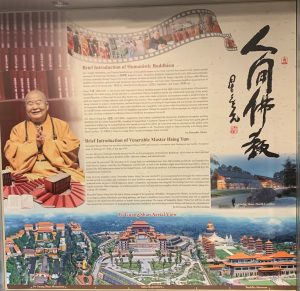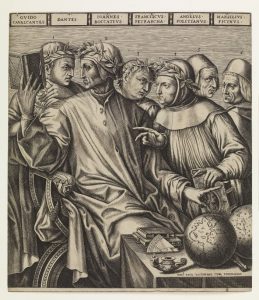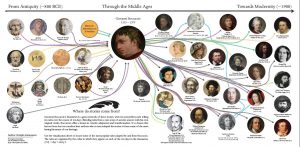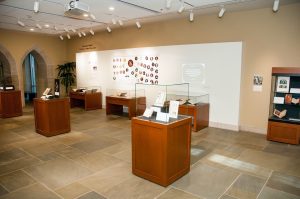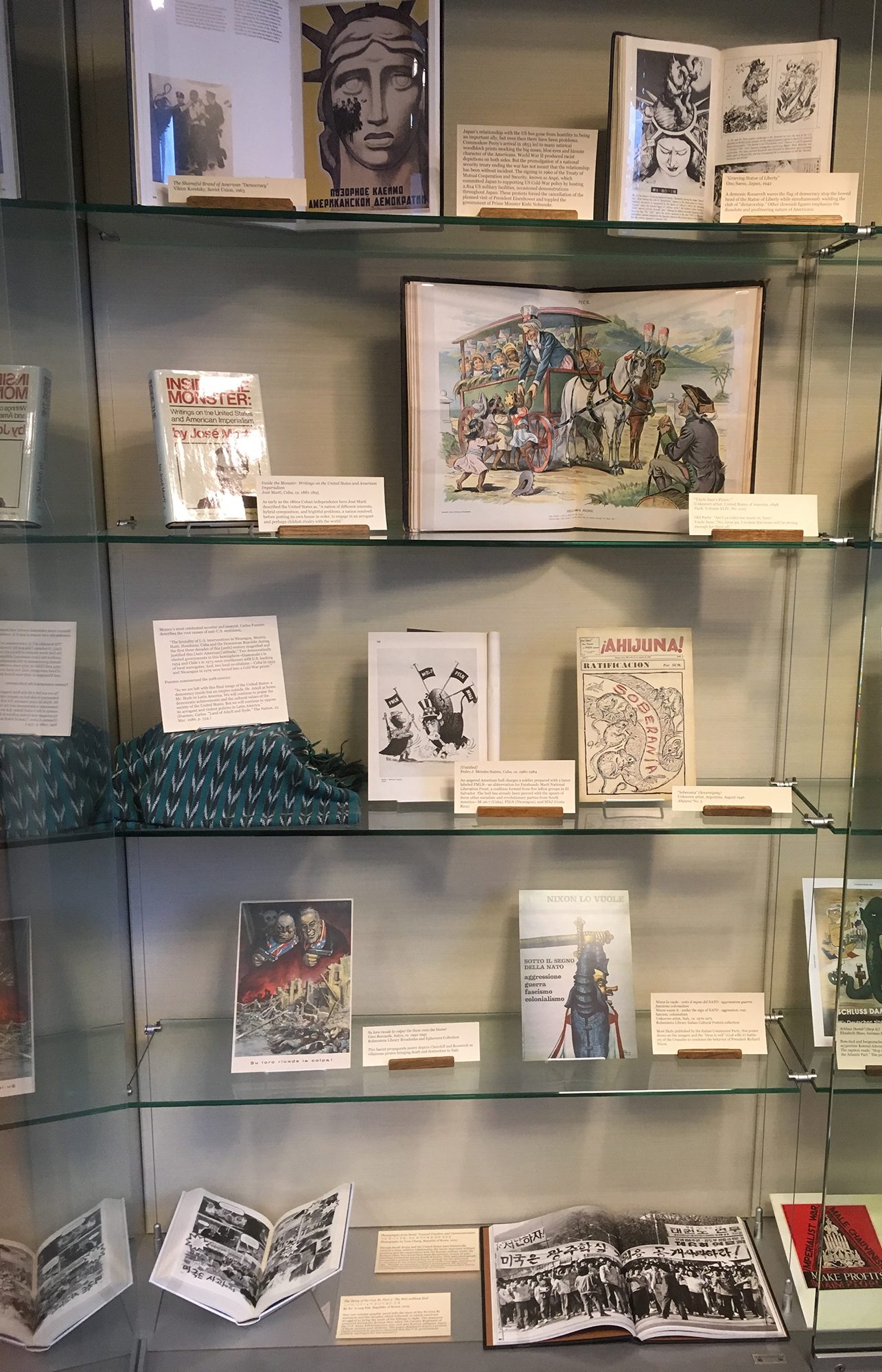 A brand-new exhibit on Humanistic Buddhism (人間佛教) has just opened in the IAS Office Exhibition Space, on the second floor of Bostock Library. This is a collaborative project between Duke University Libraries’ East Asian Collection and Fo Guang Shan Temple, located in Raleigh, North Carolina. The curators of the exhibition are Alexander Atkins, a PhD student at the Department of Religion; Master Miaozhou (妙舟), head of Fo Guang Shan Temple, North Carolina; Luo Zhou, Chinese Studies Librarian, and Matthew Hayes, Japanese Studies Librarian.
A brand-new exhibit on Humanistic Buddhism (人間佛教) has just opened in the IAS Office Exhibition Space, on the second floor of Bostock Library. This is a collaborative project between Duke University Libraries’ East Asian Collection and Fo Guang Shan Temple, located in Raleigh, North Carolina. The curators of the exhibition are Alexander Atkins, a PhD student at the Department of Religion; Master Miaozhou (妙舟), head of Fo Guang Shan Temple, North Carolina; Luo Zhou, Chinese Studies Librarian, and Matthew Hayes, Japanese Studies Librarian.
Buddhism is a fast-growing religion in the United States, and the study of Buddhism in America has seen substantial growth since 1990s. A quick search of TRLN catalog for the Library of Congress subject heading “Buddhism-United States” found that 94 out of 108 books were published after 1990. The three main streams of Buddhism in the United States are the Theravada, Mahayana, and Vajrayana. American Buddhist groups come from many national origins and ethnicities. The exhibit sheds light on a local Buddhism group and Humanistic Buddhism.
Below is the text of the introduction to the exhibit, written by Alexander Atkins:
Zen, Insight Meditation, and Tibetan Buddhism are all household names in the West, but few have heard of the massive global movement of Humanistic Buddhism (人間佛教 Renjian Fo Jiao). Humanistic Buddhism originated in the early 20th century Republic of China expanding through Taiwan into every continent. Its ideas are found within the People’s Republic of China’s (PRC) Chinese Buddhist Association, spread through Southeast Asian Buddhist groups, and many large Taiwanese Buddhist organizations in Taiwan such as Fo Guang Shan (佛光山), Dharma Drum Mountain (法鼓山 fagushan), and Tzuchi (慈濟ciji).
Taixu (太虛 1890-1947) is one of the most important Chinese Buddhist monks of the 20th century and founder of Humanistic Buddhism. He is best known for his attempts to reformulate Chinese Buddhism amidst the intellectual landscape of the newly formed Republic of China and the post-May Fourth era, a time when many academics and students sought a modern China to push out negative foreign influence and strengthen the country. Taixu sought to push against the academic trends of religion being irrelevant to science, modernization, and social improvement by presenting its importance and use through his formulation of Humanistic Buddhism. He actively argued that Buddhism was compatible with science while formulating monastic education to include science and humanities within the Buddhist curriculum. Though he judged his reform attempts as a failure and died too soon, his ideas continued to influence Chinese Buddhism throughout the world.
Ven. Master Hsing Yun (星雲 1927-2023), inspired by Taixu’s ideas, continued the Humanistic Buddhism movement as many Buddhists fled the newly founded PRC, founding Fo Guang Shan in southern Taiwan in 1967. Through Hsing Yun’s great gifts of organization and giving, Fo Guang Shan has now spread to around 200 countries. He viewed his work as carrying out the global vision for Humanistic Buddhism, making Buddhism’s benefits accessible to all. The closest temple to Duke University is North Carolina Fo Guang Shan (北卡佛光山 Beika Fo Guang Shan) located in Raleigh, North Carolina.
An introduction about the Venerable Master Hsing Yun (星雲) from Fo Guang Shan Temple, North Carolina:
Venerable Master Hsing Yun was born in Jiangsu, China in 1927 and entered a monastery near Nanjing at age twelve. He passed away on February 5th, 2023, at the age of 97.
For over 80 years, Venerable Master devoted his life to the propagation of Humanistic Buddhism, which takes to heart spiritual practice in daily life. He was a Buddhist monk, educator, author, and philanthropist.
In the past 56 years since the founding of Fo Guang Shan, he established more than 300 temples worldwide and founded five universities in Taiwan, Australia, the Philippines, and the USA, as well as the Buddha’s Light International Association, which is granted the NGO association status by the United Nation, with millions of members. Countless people have benefited from his compassionate endeavors.
Early on in his monastic career, Venerable Master Hsing Yun was involved in promoting Buddhism through the written word. He had served as an editor and contributor for many Buddhist magazines and periodicals, authoring the daily columns, and had authored books on how to bring happiness, peace, compassion, and wisdom into daily life. His writings have been translated into English and many other languages. As a lifelong prolific writer, he authored the Complete Works of Venerable Master Hsing Yun, totaling 395 volumes.
Venerable Master Hsing Yun’s life was a shining example of the teachings of Buddha. Throughout his lifetime, he dedicated himself to serving countless individuals, providing guidance and hope to Buddhists everywhere. His achievements have left an indelible impact on the world and will continue to inspire future generations. The legacy of Venerable Master Hsing Yun will live on and his unwavering commitment to propagating Humanistic Buddhism and delivering sentient beings will always be remembered.
The Humanistic Buddhism (人間佛教) exhibit is open to the public and will be up from now until the end of August. Please stop by and take a look!


